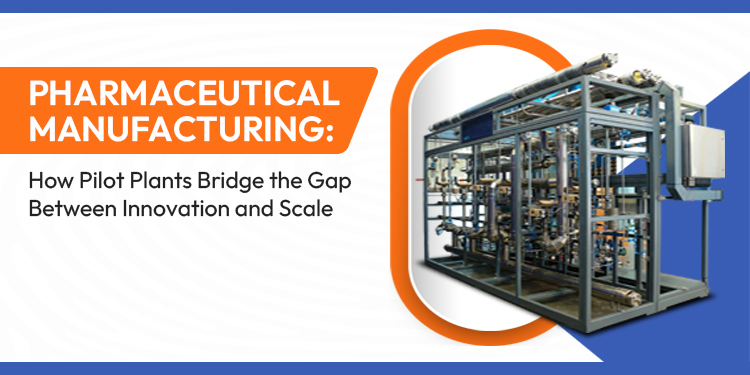Premier Pilot Plant People

Pharmaceutical Manufacturing: How Pilot Plants Bridge the Gap Between Innovation and Scale
SPharmaceutical Manufacturing: How Pilot Plants Bridge the Gap Between
The Challenge: Why Traditional Batch Processing Is Holding Us Back
For decades, batch processing has been the cornerstone of pharmaceutical manufacturing. It’s familiar, well-documented, and deeply integrated into many existing systems. But today, as pharmaceutical innovation accelerates and demands for speed, precision, and regulatory compliance grow sharper, the cracks in batch processing are becoming harder to ignore. Whether you’re dealing with slow reaction cycles, inefficient heat and mass transfer, or the dreaded scale-up unpredictability, batch systems are showing their age. Add to this the complexities of meeting Good Manufacturing Practice (GMP) requirements and maintaining consistent product quality, and the picture becomes clear: relying solely on traditional batch methods can limit how quickly and effectively new drugs are developed and brought to market. So, what’s the alternative? Enter continuous flow chemistry a modern approach that offers precise control, scalable output, and superior safety, especially when dealing with exothermic or multi-phase reactions. However, making the leap from batch to flow chemistry isn’t as simple as flipping a switch. It requires careful planning, deep technical understanding, and most importantly, a robust pilot plant.Why Pilot Plants Are Vital in Modern Pharmaceutical Development
Moving from a batch system to a continuous flow process is a major shift in how pharmaceutical products are developed and manufactured. It’s a transition that involves not just engineering, but chemistry, safety, compliance, and operational reliability. That’s where pilot plants come in. They serve as the crucial middle ground, a scaled-down, highly controlled environment where you can test, validate, and optimize before committing to full-scale production. Let’s explore how pilot plants tackle the real-world problems faced during pharmaceutical development:1. From Theory to Practice: Converting Batch Kinetics into Flow Dynamics
Lab results don’t always translate directly to production environments. What works in a beaker under controlled conditions may behave very differently in a continuous flow reactor. This is where a pilot plant proves invaluable. Pilot plants help map reaction kinetics from batch systems into scalable flow parameters. This includes fine-tuning:- Residence time — ensuring reactions complete efficiently
- Mixing regimes — optimizing the interaction of reactants
- Thermal control — maintaining safe and consistent heat levels
2. Making Safety a Built-In Feature, Not an Afterthought
Pharmaceutical processes often involve sensitive, volatile, or hazardous reactions. In a batch system, the risk of runaway reactions, pressure buildup, or poor heat dissipation can pose serious safety threats, especially as volumes increase. Continuous flow chemistry significantly improves safety by limiting reaction volumes and enabling real-time monitoring. A well-designed pilot plant allows you to test:- Pressure profiles under dynamic flow
- Thermal behavior and heat dissipation
- Containment integrity in case of abnormalities
- Quality by Design (QbD) principles
- GMP alignment and validation readiness
- Documented traceability of every test and trial
4. De-Risking Scale-Up: From Concept to Commercial Confidence
The jump from lab bench to production line is one of the most critical — and risky — phases of pharmaceutical development. Without pilot-scale validation, manufacturers often face unexpected issues like:- Uneven flow distribution
- Material incompatibility
- Fouling or clogging in reactor channels
How Xytel India Brings It All Together
At Xytel India, we don’t just build equipment — we engineer solutions. We work hand-in-hand with pharmaceutical manufacturers to design and deliver pilot plants that meet the complex technical, safety, and compliance needs of modern drug development. We understand that every pharmaceutical process is unique. From reaction chemistry and pressure profiles to regulatory demands and material selection, your process requires a tailored solution, not a one-size-fits-all box. Here’s how Xytel India makes a difference:Custom-Built Pilot Plants That Fit Your Process
Whether you’re developing a new active pharmaceutical ingredient (API), optimizing a synthesis pathway, or validating a continuous flow setup, we design pilot plants to match your specific process parameters. Our systems enable:- Precise replication of lab-scale chemistry
- Advanced control systems with real-time monitoring
- Flexible modular designs for multipurpose use
Engineering with Safety and Sustainability at the Core
Pharmaceutical reactions can be complex and sometimes dangerous. That’s why every Xytel India pilot plant includes:- Integrated safety features for pressure, temperature, and containment
- Efficient heat management systems
- Fail-safe controls and emergency shutdown protocols
Compliance-Ready Design and Documentation
Our team works closely with your compliance and quality teams to ensure that every pilot plant supports:- GMP and QbD principles
- Cleanroom integration and sanitary design
- Automated data logging and audit trails
Decades of Experience, Global Know-How
With decades of experience and a global footprint, Xytel India brings international best practices to every project. Whether you’re scaling a new formulation, conducting toxicology batches, or preparing for tech transfer, we provide deep technical expertise, proven design strategies, and long-term support.Conclusion: In a Changing Industry, the Right Pilot Plant is Your Competitive Advantage
As pharmaceutical development becomes more complex, faster-paced, and more regulated, having a pilot plant tailored to your needs is no longer optional — it’s essential. It’s your bridge between the lab and the plant. Your testing ground for innovation. Your first line of defense against scale-up surprises. At Xytel India, we are proud to be part of that journey. We’re here to help pharmaceutical manufacturers transition smoothly from batch to flow, from theory to practice, and from concept to commercialization — with safety, compliance, and confidence built in at every stage. Let’s create the future of pharmaceutical manufacturing together — one pilot plant at a time.Get in Touch
You will be amazed as how partnering with us becomes a game changer in your quest for R&D glory.

 Call Us
Call Us